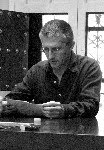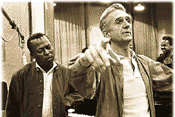No one doubts about the importance of jazz in the films by Clint Eastwood as a director, or the influence that he, with his passion for music, causes in jazz musicians. Those relationships between the characters, those Far West landscapes or those honkytonks would not "sound" the same way without jazz. That particular vision of Clint Eastwood of the vain attempts of Charlie Parker to remain standing or the complicated (and invisible) world of Thelonious Monk are part of the bible of jazz, of that dictionary that explains how and why the current jazz has become what it is. In appreciation, a wide jam of present musicians met on October 17, 1996 at Carnegie Hall in New York to record a concert to celebrate this passion for each other or, as said George Wein, host of the event, the successful way he includes jazz in his scenes.
one doubts about the importance of jazz in the films by Clint Eastwood as a director, or the influence that he, with his passion for music, causes in jazz musicians. Those relationships between the characters, those Far West landscapes or those honkytonks would not "sound" the same way without jazz. That particular vision of Clint Eastwood of the vain attempts of Charlie Parker to remain standing or the complicated (and invisible) world of Thelonious Monk are part of the bible of jazz, of that dictionary that explains how and why the current jazz has become what it is. In appreciation, a wide jam of present musicians met on October 17, 1996 at Carnegie Hall in New York to record a concert to celebrate this passion for each other or, as said George Wein, host of the event, the successful way he includes jazz in his scenes.
Released on DVD but not very easy to get, Eastwood After Hours includes themes that have appeared in his films. As a tribute, it's great: it combines an impressive cast of musicians for the occasion. Barry Harris and Kenny Barron play four hands Misty (Errol Garner), an issue that was the protagonist and the catalyst on Eastwood's first film as director. Claude Williams makes a fabulous version of San Antonio Rose (Honkytonk Man, 1982), in which Clint appeared with his son Kyle, who has composed several soundtracks, and participates in this concert with his quartet playing a version of This time the dream's on me from the movie Bird . In this track, of course, the protagonist is the sax (Doug Webb).
Among the sidemen of the rhythm section (who play almost the whole concert) are Christian McBride on bass and Kenny Washington on drums. I also really liked the Carnegie Hall Jazz Band with Kevin Mahogany, with Charles McPherson, Joshua Redman or with a superb soprano James Rivers playing the theme of Thightrope (1984), interspersed with suggestive and intriguing images from the film, with touches of blues ranging in crescendo with the help of the big band ...
Thelonius Monk jr. Thelonious Monk jr. (A.K.A. TS Monk ) appears in versions of Straight no chaser (which names the documentary), Round Midnight and I see your face before (The Bridges of Madison), although the fireworks are on charge of James Carter and Joshua Redman in the saxophones a few minutes before, playing a tremendous version of Straight No Chaser / Now 's the time in a duet at full speed, endless. It could not be more powerful. There is a spectacular finish, orgasmic:
A few issues later, Redman has another magic moment, when in Lester leaps in all the saxophones that have participated in the concert (James Rivers, James Moody, Charles McPherson, James Carter and Flip Phillips, Roy Hargrove on the flugelhorn), join. Every one contributes with his "Prez side". I could say that this is my favorite time of the concert, but later is Eastwood himself who appears on stage to thank and to play the piano, a blues with his initials, After Hours / CE Blues, accompanied by Jay McShann James Moody, Roy Hargrove and the Carnegie Hall Jazz Band, just the moment and the place where all of us would like to be, there, on the stage of The Carnegie Hall, surrounded by the best musicians and Eastwood ... He is the Grand Aficionado.
I know sometimes I get carried away by passion, but I think you will agree with me that this is one of those shows all of us would have liked to attend.

 one doubts about the importance of jazz in the films by Clint Eastwood as a director, or the influence that he, with his passion for music, causes in jazz musicians. Those relationships between the characters, those Far West landscapes or those honkytonks would not "sound" the same way without jazz. That particular vision of Clint Eastwood of the vain attempts of Charlie Parker to remain standing or the complicated (and invisible) world of Thelonious Monk are part of the bible of jazz, of that dictionary that explains how and why the current jazz has become what it is. In appreciation, a wide jam of present musicians met on October 17, 1996 at Carnegie Hall in New York to record a concert to celebrate this passion for each other or, as said George Wein, host of the event, the successful way he includes jazz in his scenes.
one doubts about the importance of jazz in the films by Clint Eastwood as a director, or the influence that he, with his passion for music, causes in jazz musicians. Those relationships between the characters, those Far West landscapes or those honkytonks would not "sound" the same way without jazz. That particular vision of Clint Eastwood of the vain attempts of Charlie Parker to remain standing or the complicated (and invisible) world of Thelonious Monk are part of the bible of jazz, of that dictionary that explains how and why the current jazz has become what it is. In appreciation, a wide jam of present musicians met on October 17, 1996 at Carnegie Hall in New York to record a concert to celebrate this passion for each other or, as said George Wein, host of the event, the successful way he includes jazz in his scenes. Released on DVD but not very easy to get, Eastwood After Hours includes themes that have appeared in his films. As a tribute, it's great: it combines an impressive cast of musicians for the occasion. Barry Harris and Kenny Barron play four hands Misty (Errol Garner), an issue that was the protagonist and the catalyst on Eastwood's first film as director. Claude Williams makes a fabulous version of San Antonio Rose (Honkytonk Man, 1982), in which Clint appeared with his son Kyle, who has composed several soundtracks, and participates in this concert with his quartet playing a version of This time the dream's on me from the movie Bird . In this track, of course, the protagonist is the sax (Doug Webb).
Among the sidemen of the rhythm section (who play almost the whole concert) are Christian McBride on bass and Kenny Washington on drums. I also really liked the Carnegie Hall Jazz Band with Kevin Mahogany, with Charles McPherson, Joshua Redman or with a superb soprano James Rivers playing the theme of Thightrope (1984), interspersed with suggestive and intriguing images from the film, with touches of blues ranging in crescendo with the help of the big band ...
Thelonius Monk jr. Thelonious Monk jr. (A.K.A. TS Monk ) appears in versions of Straight no chaser (which names the documentary), Round Midnight and I see your face before (The Bridges of Madison), although the fireworks are on charge of James Carter and Joshua Redman in the saxophones a few minutes before, playing a tremendous version of Straight No Chaser / Now 's the time in a duet at full speed, endless. It could not be more powerful. There is a spectacular finish, orgasmic:
A few issues later, Redman has another magic moment, when in Lester leaps in all the saxophones that have participated in the concert (James Rivers, James Moody, Charles McPherson, James Carter and Flip Phillips, Roy Hargrove on the flugelhorn), join. Every one contributes with his "Prez side". I could say that this is my favorite time of the concert, but later is Eastwood himself who appears on stage to thank and to play the piano, a blues with his initials, After Hours / CE Blues, accompanied by Jay McShann James Moody, Roy Hargrove and the Carnegie Hall Jazz Band, just the moment and the place where all of us would like to be, there, on the stage of The Carnegie Hall, surrounded by the best musicians and Eastwood ... He is the Grand Aficionado.
I know sometimes I get carried away by passion, but I think you will agree with me that this is one of those shows all of us would have liked to attend.
















